Reading: A Time of Malaise
A Time of Malaise
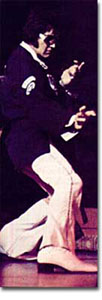
The passing of an icon: Elvis Presley died in 1977.
Something was terribly wrong in America in the 1970s.
The United States was supposed to be a superpower, yet American forces proved powerless to stop a tiny guerrilla force in Vietnam. Support for Israel in the Middle East led to a rash of terrorism against American citizens traveling abroad, as well a punitive oil embargo that stifled the economy and forced American motorists to wait hours for their next tank of gasoline.
A hostile new government in Iran held fifty-two American citizens hostage before the eyes of the incredulous world. The détente with the Soviet Union of the Nixon years dissolved into bitter animosity when a second arms control agreement failed in the Senate and a Soviet army of invasion marched into Afghanistan. The United States military juggernaut seemed to have reached its limits.
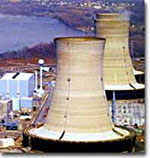
In March 1979, when word of a small radiation leak in the nuclear facility at Three Mile Island, Pennsylvania, the Governor ordered the evacuation of all pregnant women and pre-school children within a 5-mile radius of the site. A hydrogen bubble growing inside the reactor caused many people to speculate a nuclear meltdown was at hand.
At home, the news was no better. The worst political scandal in United States history forced a president to resign before facing certain impeachment. Months of investigation turned into years of untangling a web of government deceit. Details of illegal, unethical, and immoral acts by members of the White House staff covered the nation's newspapers. Upon resignation, the president was granted a full and complete pardon. Many Americans wondered what happened to justice and accountability.
The booming economy sputtered to a halt. Inflation approached 20% and unemployment neared 10% — a combination previously thought to be impossible. Crime rates rose as tales of the decaying inner cities fell on deaf ears. A nuclear disaster of unspeakable proportions was barely averted at the Three Mile Island fission plant in Pennsylvania.
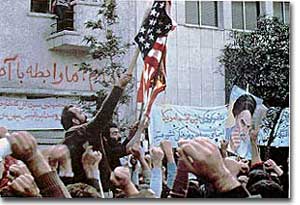
During the hostage crisis in Iran in late 1979, U.S. television broadcast videos of angry mobs in Iran burning the American flag and shouting, "Death to America." This galvanized some Americans into protesting for the release of the hostages and burning Iranian flags in turn.
Many Americans coped with the current ailments by turning inward. Outlandish fashion and outrageous fads such as streaking, mood rings, and pet rocks became common. Younger Americans finished their workweeks and sought escape in discotheques. Controversy surrounding"DECAYING MORALITY"surfaced with regard to increased drug use, sexual promiscuity, and a rising divorce rate. As a result, a powerful religious movement turned political in the hopes of changing directions toward a more innocent time.
The United States celebrated its bicentennial anniversary in 1976 without the expected accompanying optimism. Instead, while many reflected on the past laurels of American success, an overarching question was on the minds of the American people: what had gone wrong?
Undoing a President

The Watergate office complex — site of the infamous 1972 break-in that led to the first Presidential resignation in American history-- is still in use in Washington, D.C.
On June 17, 1972, five men were arrested after breaking into the headquarters of theDEMOCRATIC NATIONAL COMMITTEE located in the WATERGATE HOTEL in Washington, D.C. The burglars were not ordinary thieves. They carried wiretaps to install on telephones. They carried cameras to photograph documents. Four of the five criminals were anti-Castro Cubans who had been previously hired by the CIA. The fifth was JAMES MCCORD, the security adviser for Nixon's campaign staff known as the COMMITTEE TO RE-ELECT THE PRESIDENT, or CREEP. Although the incident failed to make the front pages of the major newspapers, it would soon become the most notorious political scandal in American history.
In the heated climate of the late 1960s and early 1970s, President Nixon believed strongly that a war was being fought between "us" and "them." To Nixon, "us" meant the conservative, middle- and working-class, church-going Americans, who believed the United States was in danger of crumbling. "Them" meant the young, defiant, free love, antiwar, liberal counterculture figures who sought to transform American values.
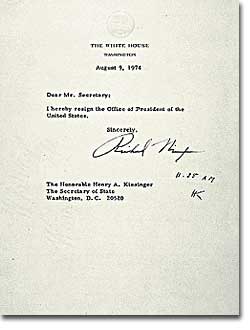
President Nixon's letter of resignation (above) is addressed to the Secretary of State — who at the time was Henry Kissinger — in keeping with a law passed by Congress in 1792. When Kissinger initialed the document at 11:35 a.m., Nixon's resignation became official.
Nixon would stop at nothing to win this war of hearts and minds, even if it meant breaking the law.
In 1971, a White House group known as the "PLUMBERS" was established to eliminate administration leaks to the press. Their first target was DANIEL ELLSBERG who had worked on thePENTAGON PAPERS, a highly critical study of America's Vietnam policy. Ellsberg leaked the Pentagon Papers — intended to be used internally by the government — to the New York Times. The Plumbers vandalized the office of Ellsberg's psychiatrist, hoping to find discrediting information on Ellsberg to release to the public.
Later that year, Attorney GeneralJOHN MITCHELL resigned to head CREEP. The campaign raised millions of dollars in illegal contributions and laundered several hundred thousand for plumbing activities. A White House adviser named G. GORDON LIDDY suggested that the Democratic headquarters be bugged and that other funds should be used to bribe, threaten, or smear Nixon's opponents. After the arrest of the burglars, Nixon suggested the payments of hush money to avoid a connection between Watergate and the White House. He suggested that the FBI cease any investigation of the break-in. He recommended that staffers perjure themselves if subpoenaed in court.
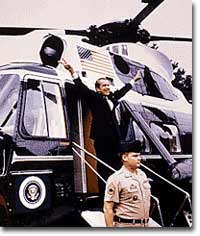
Richard Nixon delivers his trademark "V" sign with both arms as he prepares to leave the White House for the last time on August 9, 1974.
The Watergate cover-up was initially successful. Despite a headline story in THE WASHINGTON POST by BOB WOODWARD AND CARL BERNSTEIN suggesting White House involvement, Nixon went on to win 49 of 50 states in the November 1972 Presidential election against GEORGE MCGOVERN.
When the burglars were tried in January 1973, JAMES MCCORD admitted in a letter that members of the Nixon Administration ordered the Watergate break-in. A Senate committee was appointed to investigate, and Nixon succumbed to public pressure and appointed Special Prosecutor Archibald Cox to scrutinize the matter.
Complicitous in the cover-up, many high-level White House officials resigned including Nixon's Chief of Staff, BOB HALDEMAN, and his Adviser on Domestic Affairs, JOHN EHRLICHMAN. In an unrelated case, Vice-President SPIRO AGNEWresigned facing charges of bribery and tax evasion. Nixon's own personal counsel, JOHN DEAN, agreed to cooperate with the Senate and testified about Nixon's involvement in the cover-up. In a televised speech, Nixon assured told the American public "I am not a crook." It seemed like a matter of Nixon's word against Dean's until a low-level aide told the committee that Nixon had been in the practice of taping every conversation held in the Oval Office.
Nixon flatly refused to submit the tapes to the committee. When ARCHIBALD COX demanded the surrender of the tapes, Nixon had him fired. Public outcry pressed Nixon to agree to release typewritten transcripts of his tapes, but Americans were not satisfied. The tape transcripts further damaged Nixon. On the tapes he swore like a sailor and behaved like a bully. Then there was the matter of 17 crucial minutes missing from one of the tapes.
Finally, in U.S. v. Nixon, the Supreme Court declared that executive privilege did not apply in this case, and Nixon was ordered to give the evidence to the Congress.
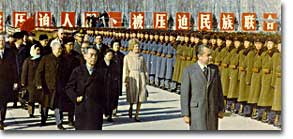
Though Richard Nixon will forever be remembered for the Watergate scandal, his foreign policy accomplishments are worth noting. Here, Nixon reviews troops during his historic visit to China that helped lessen diplomatic tensions.
By this time, the HOUSE JUDICIARY COMMITTEE had already drawn up ARTICLES OF IMPEACHMENT, and Nixon knew he did not have the votes in the Senate to save his Presidency.
On August 8, 1974, Nixon resigned the office, becoming the first President to do so. His successor, Gerald Ford, promptly awarded Nixon a full pardon for any crimes he may have committed while in office. The press and the public cried foul, but Ford defended his decision by insisting the nation was better served by ending the long, national nightmare.
During his years in office, Nixon had brought a controversial end to the Vietnam War, opened communication with Red China, watched NASA put astronauts on the moon, and presided over a healing period in American history in the early 1970s. Despite these many accomplishments, Watergate's shadow occludes Nixon's legacy.
The Sickened Economy
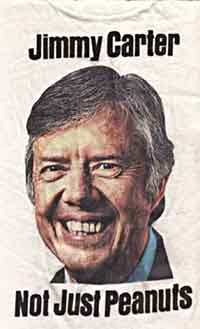
Jimmy Carter used his "common man" image to defeat Gerald Ford and capture the White House in 1976. This campaign shirt assures voters that there is more to Carter than just his previous job as a peanut farmer.
Malaise Noun. 1) An indefinite feeling of debility or lack of health. 2) A vague sense of mental or moral ill-being.
People can feel malaise. Nations can feel malaise. Economies can feel malaise. In the mid-1970s much of America suffered a collective MALAISE.
Nothing fuels a strong case of malaise like a sputtering economy. The United States had grown accustomed to steady economic growth since the end of World War II. Recessions were short and were followed by robust economic growth. For the first time since the Great Depression, Americans faced an economy that could result in a lower standard of living for their children.
Inflation, which crept along at one to three percent for the previous two decades, exploded into double digits. Full employment, defined as five percent or less, had been achieved in most years since 1945. Now the unemployment rate was nearing the dangerous ten percent line. Americans asked the question: what went wrong?

Gerald Ford hoped to curb the inflation rate with his "Whip Inflation Now!" or "WIN" campaign of 1974. Despite this effort, inflation continued to rise throughout the 1970s.
Economists had long held that inflation and unemployment were polar forces. High inflation meant a great deal of spending; therefore, many jobs would be created. Unemployment created jobless Americans with less money to spend; therefore, prices would stay the same or fall. Surprisingly, the United States experienced high unemployment and high inflation simultaneously in the 1970s — a phenomenon called stagflation. Experts and commoners debated the roots of this problem with differing opinions.
One possibility was the price of oil. When Israel defeated its Arab neighbors in the Yom Kippur War of 1973, Arab oil producers retaliated against Israel's allies by leading theORGANIZATION OF PETROLEUM EXPORTING COUNTRIES (OPEC) to enact an embargo. Oil prices skyrocketed immediately in the United States as the demand outstripped the supply. Automobiles and drivers sat in long gas lines at service stations.
The price of oil is independent of other factors such as falling worker productivity and foreign competition, which led to greater unemployment. Oil prices also influence the prices of all consumer goods. Products that require oil to produce would now cost more. Any commodity shipped by truck or airplane would pass its new expenses off to the consumer. As the decade progressed, the embargo was lifted, but OPEC steadily raised prices each year. The price of a gallon of gasoline more than tripled from the 1970 to 1980.
Richard Nixon tried to fight inflation first by cutting government spending, but ultimately by imposing wage and price controls on the entire nation. GERALD FORD watched the inflation rate soar above 11 percent in 1974. He enacted a huge propaganda campaign called WHIP INFLATION NOW (WIN), which asked Americans to voluntarily control spending, wage demands, and price increases. The economy, along with Watergate disillusionment, led Ford to suffer defeat at the hands of JIMMY CARTER in the 1976 Presidential election.

The Organization of the Petroleum Exporting Countries — or OPEC — consists of 11 member nations that currently supply more than 40% of the world's oil. Seen here are representatives of the member nations in 1999.
Carter tried tax and spending cuts, but the annual inflation rate topped 18 percent under his watch in the summer of 1980. At the same time, the unemployment rate fluctuated between 6 and 8 percent. Economic woes may well have been the decisive factor in Carter's defeat to Ronald Reagan in the election of 1980.
Foreign Woes
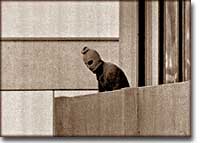
Palestinian terrorists — like the one seen above — were responsible for the murder of 11 Israeli athletes, coaches, and judges during the 1972 Olympics. The terrorists were hoping to force the release of 200 Arabs being held in Israeli prisons.
America sank deeper into malaise when it looked around at what was going on in the rest of the world.
The decade began with America's longest war ending in its first decisive military defeat in its 200-year-history. Diplomacy seemed powerless to stop the economic dependence of the United States on the volatile Middle East for a steady supply of oil. Terrorists from this region and others threatened heads of state and ordinary citizens around the globe. Despite an auspicious start, relations with the Soviet Union deteriorated by the end of the decade.
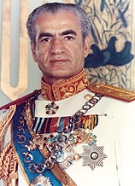
Shah Mohammad Reza Pahlavi was the impetus for the 1979 seizure of the U.S. Embassy in Tehran by the Iranian government. The terrorists demanded the return of their former leader Pahlavi in exchange for the lives of 52 American hostages.
Terrorism was on the rise around the globe. The world watched in horror as Arab gunmen cut down eleven Israeli weightlifters at the 1972 OLYMPICS in Munich. TheIRISH REPUBLICAN ARMY (IRA) killed thousands of English and Irish citizens attempting to receive recognition for their cause — an independent homeland. Americans began to see the world slipping into anarchy and felt powerless to fix the problem.
In 1979, the new Islamic fundamentalist government of Iran captured 52 Americans at the US Embassy inTEHRAN. They demanded the return of their former leader, SHAH MOHAMMED REZA PAHLAVI, to Iran in exchange for the lives of the hostages. For 444 days, Americans watched helplessly as their fellow citizens were held in confinement. A rescue effort ordered by President Carter crashed in the desert in April 1980.
Malaise, malaise, malaise.
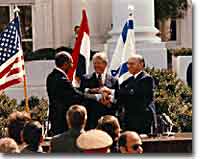
Though Jimmy Carter's presidency is often remembered for creating a sense of "malaise" throughout America, Carter was able to take a great step towards peace in the Middle East. Here, Carter, Anwar Sadat, and Menachem Begin celebrate the signing of the Camp David Accords.
One exception to these negative trends was the CAMP DAVID AGREEMENT, brokered by Carter in 1978. These accords resulted in the mutual recognition of Israel and Egypt, a giant first step toward a lasting peace.
But the U.S.-USSR détente arranged by Nixon and Kissinger was crumbling by the end of the decade. A second arms limitation treaty between the superpowers known as SALT II was delivered to the Senate — only to be rejected. The USSR had surpassed the United States in nuclear warheads. The Cold War became frostier.
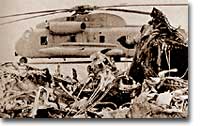
After the Iranian government took 52 Americans hostage at the U.S. Embassy in Tehran in 1979, President Carter mounted a rescue effort that ended in tragedy. Eight American pilots participating in "Operation Eagle Claw" lost their lives when two aircraft collided.
A Marxist revolution in NICARAGUA brought greater fears of communism spreading to the Western Hemisphere. Finally, in 1979 the Soviet Union invaded AFGHANISTANwith combat troops from the Red Army. Soviet Premier Leonid Brezhnev promised that Afghani leaders had requested military assistance, but American diplomats were dubious.
Fearing Soviet expansion into the Middle East, the Carter Administration strongly condemned the action and levied a wheat boycott on the Soviet Union. The 1980 OLYMPIC GAMES held in Moscow were boycotted by the United States.
America's claim to dominant status in the world had been seriously challenged, by the end of the 1970s.
So, Americans started looking inward, inside themselves, in the hope of feeling better.
Finding Oneself
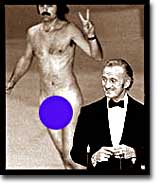
The 1970s desire to "find oneself" often resulted in people getting naked in public. The height of the streaking craze came in 1974 when a naked man zoomed across the stage during the Academy Awards ceremony in Los Angeles.
TOM WOLFE called the 1970s the "ME DECADE."
Across the land, Americans seemed determined to escape from the wars and social movements of the previous decade. Disillusionment with national and global action led many to look inward and find solace in discovering more about themselves.
A magazine entitled SELF sold thousands of copies. Women demanded respect as equal partners. Fashions veered toward the outrageous and ridiculous, reflecting the glorification of rule breaking and self-expression. The sexual revolution took hold from the inner city to the small town. Therapy sessions mushroomed as Americans in all walks of life searched to find "the real me."
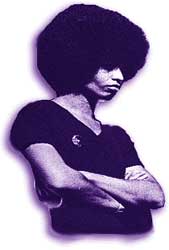
Many during the '70s wore the "afro" hairstyle simply as a fashion statement. But to others it signified a shift toward more aggressive expressions of African American identity.
Every rule of fashion was shattered in the 1970s. Lapels, ties, and collars, reached record widths. The polyester leisure suit, available in a palette of citrus and pastel colors, was extremely popular among young males. The jacket, pants, and vest were often worn with an open collar to display thick necklace chains nestled in exposed chest hair. Hair was large and long for both males and females. Afros proved popular. Sideburns were long and bushy.
Bellbottom jeans and hiphuggers were the rage on many college campuses in the early 1970s. Platform shoes, which sometimes added as much as a foot to a person's height, were introduced. Despite the machinations of the fashion industry, skirts remained short for much of the decade, and the string bikini shocked or delighted millions on America's beaches. In the late 1970s big name labels become appealing as thousands of Americans rushed to purchase expensive designer jeans.
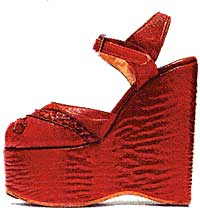
The platform shoe was just one of many fashion fads of the 1970s. Some platform shoes were so high that they increased the height of the wearer by a full foot.
The sexual revolution had its roots in the 1960s, but this trend moved from the college campuses to the average American household in the 1970s. Birth control was more widely used, and young people experienced more sexual partnerships with different people. Venereal diseases became much more widespread.
As women asserted themselves economically, socially, and politically, the idea of remaining trapped in an unhappy marriage became less and less appealing. Consequently, the divorce rate soared. An 1974 book entitled THE COURAGE TO DIVORCE encouraged individuals to put their own happiness above that of their spouses and children.
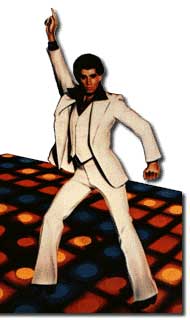
With his leisure suit, bellbottoms, gold medallion and platform shoes, John Travolta brought disco culture to the big screen as "Tony Manero" in the 1977 film Saturday Night Fever.
Nowhere was the self-indulgence of the 1970s more evident than in the fads of the decade. New forms of therapy were introduced to help a person find oneself.DISCO music and the disco scene capitalized on the widespread desire to forget daily troubles and just have fun. Temperature-sensitive mood rings were a bogus attempt to display inner feelings outwardly. Public streaking showed a desire to break society's norms and to show comfort with one's own body.
The height of the ridiculous was reached in 1975 when an entrepreneur named GARY DAHL sold common rocks to thousands of Americans advertised as the PET ROCK. These "pets" were peddled with accessories and guidebooks, incurring the wrath of cultural critics across the nation who believed a new low had been reached. Whether Americans were searching for meaning, escaping from the daily grind, or simply looking for a good laugh, the 1970s marked the height of self-expression, mixed with a healthy dose of absurdity and poor taste.
The New Right
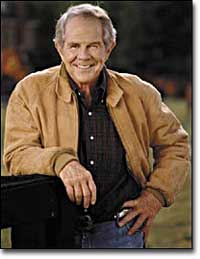
Pat Robertson was among the new breed of "televangelists" that rose to political and cultural prominence in the late 1970s and early '80s. Robertson used his television station "The Christian Broadcast Network" to deliver a conservative message to millions.
Not everyone was happy with the social changes brought forth in America in the 1960s and 1970s. When Roe vs. Wadeguaranteed the right to an abortion, a fervent pro-life movement dedicated to protecting the "unborn child" took root.
Antifeminists rallied against the Equal Rights Amendment and the eroding traditional family unit. Many ordinary Americans were shocked by the sexual permissiveness found in films and magazines. Those who believed homosexuality was sinful lambasted the newly vocal gay rights movement. As the divorce and crime rates rose, an increasing number of Americans began to blame the liberal welfare establishment for social maladies. A cultural war unfolded at the end of the 1970s.
Enter the New Right.
The NEW RIGHT was a combination of Christian religious leaders, conservative business bigwigs who claimed that environmental and labor regulations were undermining the competitiveness of American firms in the global market, and fringe political groups.
There was nothing new about political and economic conservatism. BARRY GOLDWATER based his 1964 Presidential campaign on the premise that the New Deal should be reversed. He declared that big government was the greatest threat to American liberty. Social spending and welfare needed to be cut to reduce the tax burden on individuals and families. Government regulations were inhibiting economic growth and personal freedoms. When foreign competition made inroads against American corporations in the 1970s, many people began to believe Goldwater had been right. Big business wielded its financial resources as a backbone of the NEW RIGHT MOVEMENT.

Religious broadcasters in the late 1970s and '80s took advantage of the boom in cable and satellite television by creating stations and networks that reached more people than ever before.
Another linchpin of the conservative backlash was the CHRISTIAN RIGHT. Since the 1950s, members of the evangelical Christian denominations increased fivefold. By the mid-1970s, over a quarter of adult Americans identified themselves as born-again Christians.
The Christian Right had many faces.FUNDAMENTALISTS such as JERRY FALWELLbelieved in a literal interpretation of the Bible. Pentacostalists such as PAT ROBERTSON claimed the Holy Spirit communicated directly with people on a regular basis.
Despite theological divisions, all evangelical leaders agreed that America was experiencing a moral decline. They explained that homosexuality was a crime against God, and that a woman's place was in the home in support of her family. They criticized the "liberal" media for corrupting America's youth. They chided the courts for taking religion out of the public schools and supported private Christian academies and homeschooling as alternatives.
Many Catholic Americans agreed with the sentiments of the New Right. The reforming spirit of the Catholic Church reached its high water mark in the 1960s with a convention called VATICAN II. Latin was dropped as a requirement for the mass. Lay people were given a greater role in Church services. Support was given for ecumenical outreach to other Christian denominations and Jewish synagogues.
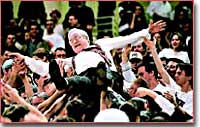
"If all the fundamentalists knew who to vote for and did it together, we could elect anybody." -Jerry Falwell, 1979
Social politics of the time forged connections between Catholic and Protestant leaders. Abortion and "FAMILY RIGHTS" were seen as areas of common ground. The appointment of the conservative JOHN PAUL II in 1979 marked an end to the reform spirit within the Church.
New Right leaders were highly organized and understood the potential of mass telecommunications. PAT ROBERTSONformed the CHRISTIAN BROADCASTING NETWORK to send his message. The PTL (PRAISE THE LORD) Club led by JIM BAKKER transmitted faith healing and raucous religious revival to the largest viewing audience of any daily program in the world. They built massive databases containing the names and addresses of potential financial contributors and regularly solicited funds. In 1979, Jerry Falwell formed the MORAL MAJORITY, Inc. This group and hundreds of others raised money to defeat liberal senators, representatives, and governors. They sought to control school boards on the local level to advance their conservative agenda. Ronald Reagan freely accepted contributions from the New Right on his way to the Presidency in 1980.
Like most movements, the New Right contained an extremist element. Racial hatred groups like the Ku Klux Klan and the AMERICAN NAZI PARTY joined the outcry against American moral decline. Ultra-libertarian militia groups formed in many states dedicated to attacking the American government they believed had become far too invasive. They steadfastly supported the right to bear arms as a means to defend themselves from tyranny. Some groups began stockpiling arsenals. These organizations interpreted the term "cultural war" in the most literal, ominous sense.
For many, the end of the '70s seemed shrouded in a dark malaise.
But morning in America was about to dawn.
